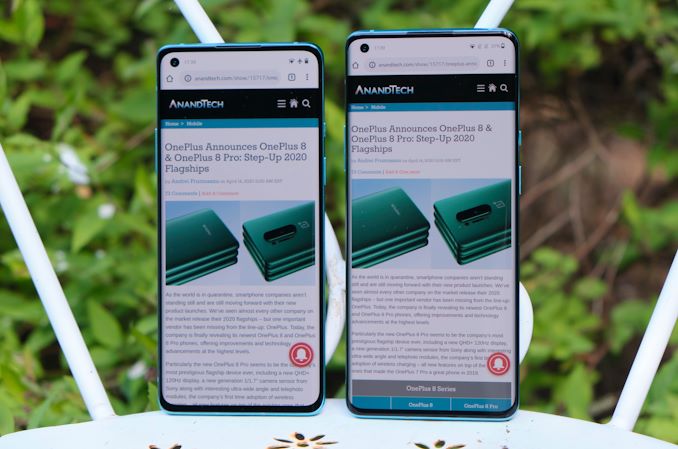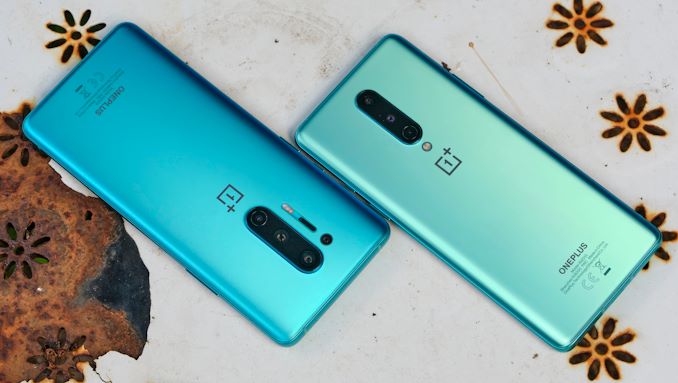The OnePlus 8, OnePlus 8 Pro Review: Becoming The Flagship
by Andrei Frumusanu on June 29, 2020 10:00 AM ESTConclusion & End Remarks
As we’re coming to and end of the review, the biggest question for both the OnePlus 8 and OnePlus 8 Pro is whether they’re devices worth buying.
Design-wise, I really do like what OnePlus has done with both variants. On the OnePlus 8 Pro I’m happy that they dropped the pop-up camera module in favour of a hole-punch front camera setup. Whilst this abandons the seamless full screen experience, the phone is able to gain on internal component spaces that goes to the batteries and cameras and it also gains IP68 certification – all whilst losing weight compared to its predecessor.
I really loved the ergonomics of the smaller OnePlus 8 and this has been easily my favourite form-factor and the best feeling device of the past few years. The symmetrical curves on the front and back glass are a better implementation than the more pronounced display curvature of the OnePlus 8 Pro. We’ve seen other vendors revert on their screen curvature choices and I think OnePlus would also require such a design adjustment in the future.
If you’re opting to get one of the phones – chose one with the matte frosted glass finish. It not only avoids fingerprints a lot better than glossy glass, but it also feels and just looks better. Overall, I think OnePlus did an excellent job on the design of the phones.
The displays of the phones are both fantastic, although obviously the regular OnePlus 8 has lower specifications, going only up to 1080p and 90Hz. The OnePlus 8 Pro’s QHD 120Hz display looks and feels amazing – there’s very little to critique about the phone other than maybe its colour calibration which really wasn’t up to par on my review sample. OnePlus here should spend less on the marketing side and more on the engineering and quality assurance side of things.
Performance of both phones is top-notch, although it’s just in line with other Snapdragon 865 devices. The OnePlus 8 Pro’s 120Hz mode outstanding for scrolling content, and is just second to the S20 series in terms of snappiness. We’ve tested a slew of different new Snapdragon 865 phones recently and they’ve all shared in common excellent GPU sustained performance and thermal characteristics, essentially showcasing no slowdown at all during prolonged usage periods, making the OnePlus 8 and 8 Pro amongst the best Android gaming devices on the market right now.
Battery life was surprising in that the regular OnePlus 8 exceeded our expectations, testing in amongst the longest lasting devices in our mobile suite. The OnePlus 8 Pro’s battery life wasn’t as good – as expected and matching the characteristics of the Galaxy S20 phones, the 120Hz display comes at a great cost to battery life as the software ecosystem just isn’t ready for true variable refresh rate operation.
The OnePlus 8 at 90Hz actually outperformed the OnePlus 8 Pro at 60Hz – and the difference grows to a 32% lead when comparing the two phones in 90Hz vs 120Hz modes. That’s a tough compromise to make given that the smaller phone has a smaller battery – although yes you do get a higher resolution screen and higher refresh rate experience that is indeed noticeable.
On the camera side of things, the regular OnePlus 8 is good – but I wouldn’t quite say it competes quite as well in the flagship segment against the competition. The OnePlus 8 Pro on the other hand easily has a flagship class camera system that not only holds up well with the competition, it even manages to beat them in some aspects such as low-light photography. It’s not a perfect camera system and OnePlus still has to work on their processing, but it’s the best camera experience that the company has ever been able to showcase to date.
In the end, the question of whether the new OnePlus 8 phones are worthy purchases comes down to their prices. Starting with the OnePlus 8 Pro – I think the phone’s starting $/€899 price point the phone easily competes against its closest competitor, that being the S20+. It’s an extremely tough toss-up in almost all aspects of the two phones which is a testament to the fact that the OnePlus 8 Pro is a true flagship device. If you’re in an Exynos market – the OnePlus 8 Pro’s Snapdragon 865 chipset is the obvious choice for better performance and battery life. In the US, the obvious value choice goes to OnePlus again as here we’re still seeing a $300 price gap – with very little compromises in terms of features or quality.
For the OnePlus 8 which starts at $/€699, there’s actually very little competition out there at this price range when what you’re looking for is performance and battery life – as the phone fully delivers and excels on both those aspects. The camera system doesn’t quite match up to an S20 for example, but it also undercuts the S20 by 100€ in Europe. In the US where the S20 is still $999, the differences (QHD screen, 120Hz, wireless charging) between the phones are more easily rationalised by their larger pricing gap.
Overall, I can easily recommend both OnePlus 8 phones – and I don’t think anybody would be disappointed with their purchases. OnePlus was able to produce excellently balanced devices in terms of quality and features as well as their value propositions, and so far, have been a highlight of 2020’s smartphone line-up.












92 Comments
View All Comments
wr3zzz - Monday, June 29, 2020 - link
Same here. The dual speakers setup used on OnePlus7/8 does not sound good, or correct, for video viewing.What happened to display audio that don't need speaker holes? Sony and LG had them a few years back and then never heard from again.
Kishoreshack - Monday, June 29, 2020 - link
I really love the one plus displayIt feels even smoother & sharper than s20 line up
One plus has been constantly delivering better displays even than the display manufacturer Samsung itself
It's a shame Samsung who manufacturers display can't deliver the smoothest sharpest display
On the market
NOTELLN - Monday, June 29, 2020 - link
It seems phones are more about bragging rights than how they actually perform now a days. $1000usd for a phone? No thank you.flyingpants265 - Monday, June 29, 2020 - link
It's about profit, market share, and demand. They just started arbitrarily raising price, and decided it was better to sell slightly fewer phones, at a much higher price. It's called market capitalism. It's awful.Also, around here, the telcos are helping subsidize certain phones again, AND financing: every phone is available for $0 now. So we may only see higher prices.
Nexus 5 was $299 (I think? Don't remember really). OnePlus One was around the same price.. Redmi K20 whatever was $420
If you look at Realme X, it's $145 USD for a 1080p FULLSCREEN phone with SD765. So they can easily make budget phones and sell them at a slight profit... But they artificially limit sales of phones by region!! It barely even works in North American networks.
Quantumz0d - Monday, June 29, 2020 - link
Exactly, the Android OS is already saturated and removing features like Filesystem advantage and shoving iOS crap into it. The worst part is as you said the insane price tag, this POS phone what does it do better than an S10+ for the same price retail currently, for non tinkerers it does nothing. It has a BL unlock but apart from that S10+ trumps this garbage clone CCP device in everyway.Kishoreshack - Monday, June 29, 2020 - link
Their commitment to the display tech is a testament in itself how far they have comeThey are literally beating display manufacturer SAMSUNG in terms of Quality
Sharma_Ji - Monday, June 29, 2020 - link
Lmao, 1+ fanboy.Just stop.
mobutu - Monday, June 29, 2020 - link
More interested in the OnePlus Nord or whatever they'll end up calling it.mrochester - Monday, June 29, 2020 - link
Why is the manual brightness on android phones so low?Andrei Frumusanu - Monday, June 29, 2020 - link
Probably to avoid having people needlessly blasting the brightness at full intensity all the time.